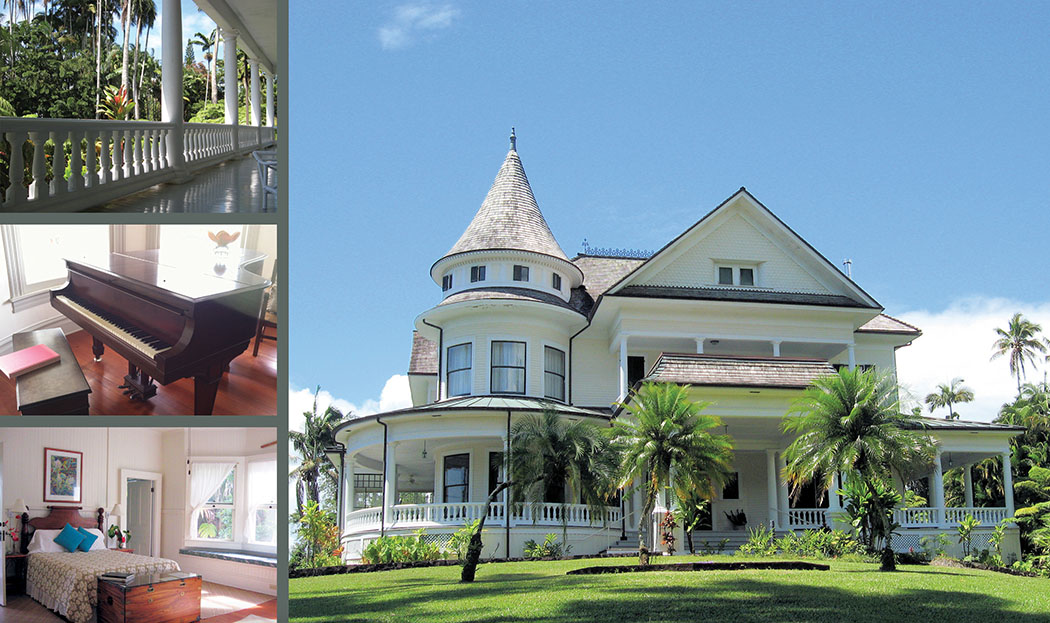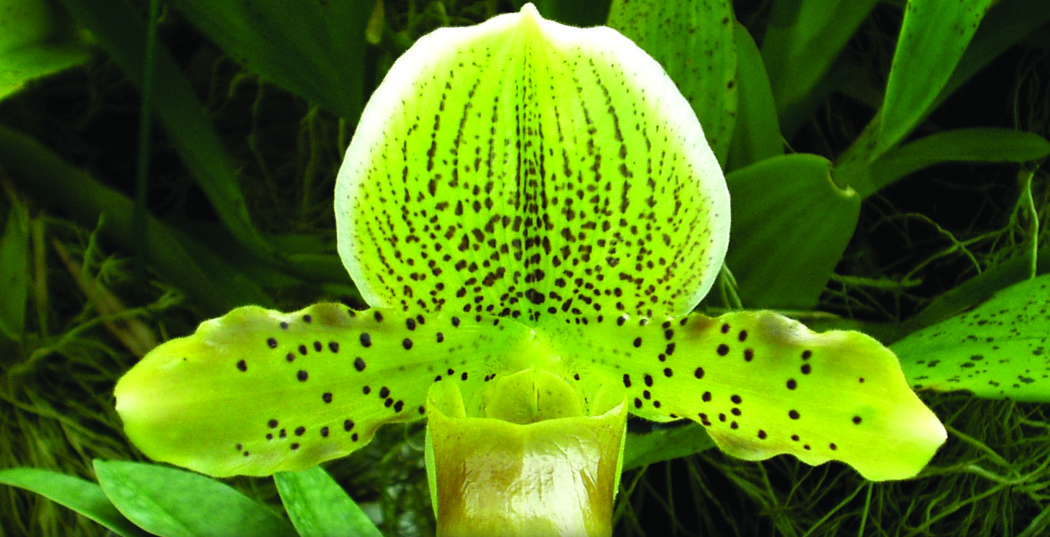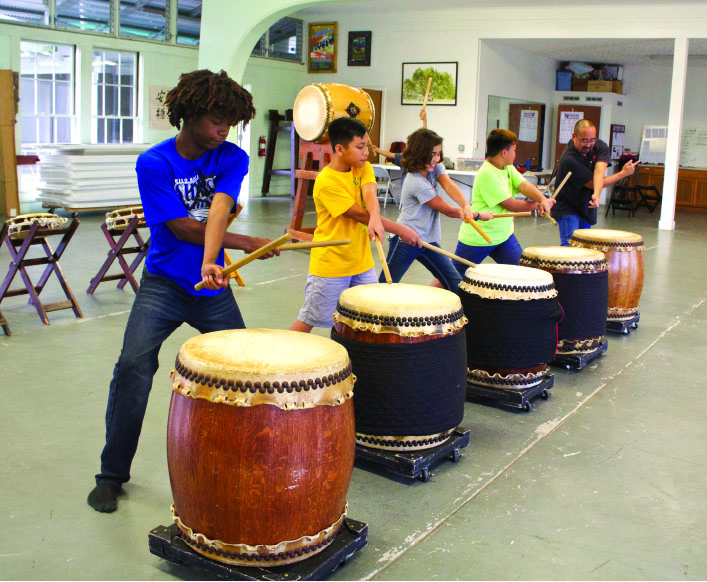
Taiko Drumming
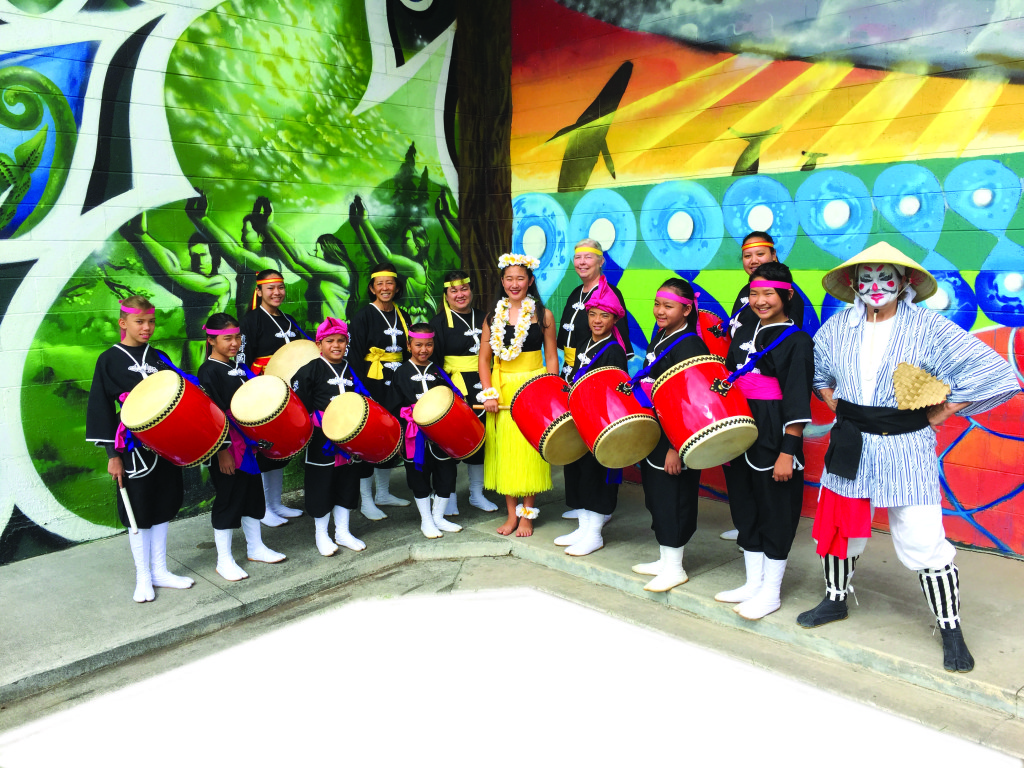
By Denise Laitinen
There is something intrinsically mesmerizing about percussion—drummers performing in unison, beating out rhythms both simple and intricate. That rhythmic enchantment has led in part to the rise in popularity of Japanese taiko drumming across Hawai‘i Island, the continental US, and beyond.
A relatively new musical genre
Various types of drumming date back more than a millennia in Japan: in religious ceremonies, on battlefields, and in some community gatherings. When Japanese immigrants came to Hawai‘i to work on the sugarcane plantations, they brought many of their cultural practices with them and taiko drumming in bon odori (dances) in Hawai‘i date back over a hundred years. However, the type of taiko drumming most commonly seen and performed today is kumi-daiko, or ensemble drumming, a relatively new art form originating in 1950s Japan with Osuwa Daiko of Nagano Prefecture founded by Daihachi Oguchi.
“There’s temple drumming and folk music of old drumming,” says Paul Sakamoto, director of Puna Taiko. “But in terms of taiko as a stage performance, it’s about 60 years old.”
While several local groups, like Taishoji Taiko of Hilo, specialize in kumi-daiko, other taiko groups specialize in performing at bon odori, community events held in the summer to honor one’s ancestors. Plus there is the Eisa style of taiko, a form of drumming from Okinawa.
“Including the bon dance groups and Okinawan groups, there are eight groups on island, which is a lot,” says Paul.
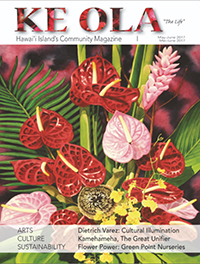
Some groups, like Kona Daifukuji Taiko and Taishoji Taiko, have been around since the late 1980s, although there has been a tremendous amount of growth and interest in taiko drumming in the past 10–15 years. When Puna was founded in 2003, the group was the fourth taiko group on island. “We came on just as it was really exploding,” says Paul.
Other groups, like the Ryukyukoku Matsuri Daiko (RMD) in Kohala and Waimea, are newer and see taiko as part of a cultural renaissance of Okinawan arts and traditions. Ryukyukoku Matsuri Daiko originated in Okinawa in the 1980s, and was first introduced to Hawai‘i on O‘ahu in 1996. There are two Okinawa taiko groups on island, including Hui Okinawa Kobudo Taiko in Hilo and Ryukyukoku Matsuri Daiko, which has groups in Kohala and Waimea.
While taiko drumming is firmly rooted in Japanese culture, members of local taiko groups span a variety of ethnic backgrounds, including Japanese, Filipino, Caucasian, and African-American. The inclusiveness of the groups and their willingness to share and learn from one other has added to the increased popularity of the musical genre as it appeals to a wide range of people.
“It’s not structured or governed like martial arts, so it’s very loose and collegial, in the sense that groups help each other out,” says Paul. “You have a folk art that’s old, but you have sharing of ideas across borders due to social media.”
Each taiko group has its own style and influences. “We’re all innovating, we’re all learning from different influences, and were all sharing from each other,” adds Paul. Some strictly follow songs and styles from Japan or Okinawa, while others incorporate rhythms from Polynesia or modern hip-hop. Several of the taiko groups perform original music composed by their group leader. For instance, Chad Nakagawa, artistic director of Taishoji Taiko, likes to layer simple rhythms with complex patterns into his original compositions for the Hilo-based group.
Drummers from keiki to kupuna
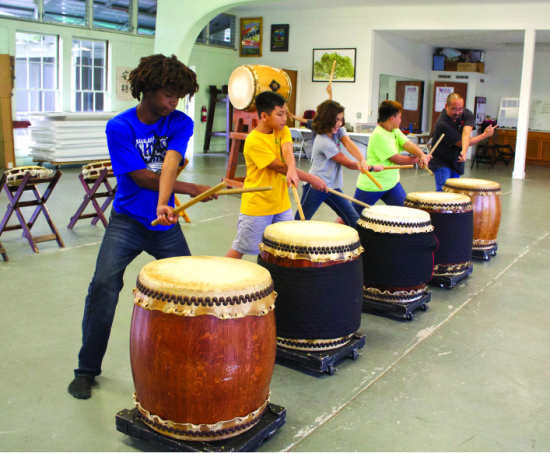
In addition to being from different ethnicities, members of Hawai‘i Island taiko groups range in age from children to senior citizens. For instance, Kona Daifukuji Taiko, which was founded by Reverend Ryuji Tamiya of the Daifukuji Soto Mission, was formed as a youth group for the Buddhist temple. Ryukyukoku Matsuri Daiko in Kohala also started out by working with youth. RMD O‘ahu instructors Melissa Ching and Jonathan Loomis first taught classes on the Okinawan style taiko in 2005 at Children’s Day Camps in Kohala with director Kathy Matsuda formally creating RMD groups in Kohala and Waimea in 2008 and 2009 respectively. Today, the 25 members of the RMD Kohala and Waimea groups range in age from 6 to 70+.
When Earl Ikeda, minister of Puna Hongwanji, started Puna Taiko, he originally envisioned it as an after-school activity for school-age kids. However, when the group first formed, its members were decidedly older. One of the original members of the group, Paul says the Puna Taiko group started with nine senior citizens, including his grandmother, and a handful of 30-something year-old men. Paul, who worked as a teacher at Kea‘au High School at the time, formed an afternoon taiko class at the school. That class and the Puna Taiko class were eventually combined, and today the group focuses on youth, with members ranging in age from middle school to college, although they also hold weekly adult classes.
Taiko instruments
While taiko drumming features a wide variety of drums, there are four common types of drums used by island taiko groups.
Odaiko are the largest drums used in taiko—literally, “big, fat drum.” They can weigh several hundred pounds and are sometimes mounted on stands. Depending on the size of the odaiko, two performers may play the drum at the same time.
Chu-daiko (also known as nagado or miya taiko) are like odaiko in that they are also made from the trunk of a single tree and the skins are nailed around the top of the side of the drum. Although chu-daiko are smaller than the massive odaiko, they are still substantial in size. Like the odaiko, they might be placed on a stand, either vertically, horizontally, or at an angle to vary the sound of the drum.
Okedo-daiko are somewhat smaller than chu-daiko and are made from slats of wood or wooden barrels (“oke” means barrel in Japanese). These types of drums are lightweight and can be tuned since the drum skin is attached with rope instead of nails.
The smallest type of taiko drum is the shime-daiko. Like the okedo, these drum skins are also fastened with rope. However, the shime drums are typically made of a lighter wood and have a higher pitch, which contrasts well with the deep tones of the odaiko.
The drumsticks used in taiko are called bachi and are typically made from different types of wood, such as beech, Japanese cypress, and magnolia trees, among others. Bachi themselves vary tremendously in style, size and shape. For instance, bachi for shime drums are quite light, while those used on the large odaiko drums are long and heavy.
Prices of taiko drums are not for the faint of heart. A small shime drum can be $1,000 or more, while large odaiko drums can easily cost more than $50,000. Taiko drums made in Japan tend to be expensive because they are labor intensive, requiring months to make a single drum. The larger drums are sourced from a single tree, a practice that is becoming harder to do as certain woods become scarce and there are few master taiko drum makers available. Because of the prohibitive cost of taiko drums made in Japan, many local taiko groups have learned to make their own drums.
When Ryukyukoku Matsuri Daiko Hawai‘i taught their first taiko class at a Children’s Day Camp in Kohala, they made odaiko drums made out of five-gallon buckets and duct tape. Students at Puna Taiko started out using tires wrapped in duct tape.
Groups like Puna Taiko make their own drums because it is a lot cheaper. The drums are made from recycled oak wine barrels from the mainland and the skins are rawhide from Oklahoma. From start to finish, it takes about a month to build a single taiko drum, says Paul.
Given the bulky nature of the drums and their loud noise, members of taiko groups tend to have group practices. Those groups that focus on performing at obon dances tend to be busier during the summer, while those that perform year-round practice more often.
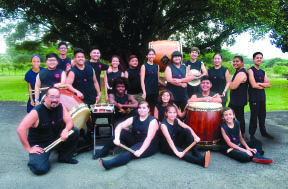
Youth members of Puna Taiko practice three hours twice a week, plus teach a class on Sunday to elementary school kids, as well as an adult class. That’s on top of a performance schedule that incudes three to four concerts a month.
RMD Kohala perform upwards of 30 times a year at community events ranging from weddings, Veterans Day programs, and community events. Kona Hongwanji Taiko performs at bon dances from Kona to Waimea to Pa‘auilo. Both Kona Hongwanji Taiko and RMD also perform at the annual Cherry Blossom Festival in Waimea, as well as the Kona Coffee Festival. Taishoji Taiko and Puna Taiko have performed at festivals on Maui and Taishoji Taiko has performed at the North American Taiko Conference in Las Vegas in 2015.
Perhaps the biggest taiko event on island is the Big Island Taiko Festival, which is held every two years at UH Hilo Center for the Performing Arts. Taiko drumming enthusiasts are in luck as the next Big Island Taiko Festival will take place June 3–4 (see sidebar for more info.) Both new and existing fans of taiko drumming will enjoy hearing a wide variety of musical styles and original compositions in this premiere festival that draws from the best of Hawai‘i Island taiko.
Big Island Taiko Festival
Fans of taiko drumming will want to check out the Big Island Taiko Festival taking place Saturday, June 3, at 7:30pm and Sunday, June 4, at 2:00pm at the UH-Hilo Performing Arts Center. Five top taiko groups from across the island will be performing as part of his energetic festival, including:
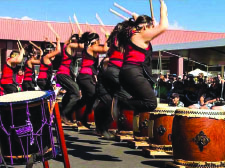
- Taishoji Taiko
- Puna Taiko
- Kona Daifukuji Taiko
- Hui Okinawa Kobudo Taiko
- Ryukyukoku Matsuri
- Daiko Kohala/Waimea
All five groups will perform together as part of the opening and closing numbers of the show with each troupe performing new numbers specifically for the festival. This festival is a must-see event for fans of taiko drumming because it is held only every two years and won’t be offered again until 2019.
“The taiko groups tend to perform quite often around the island throughout the year,” says Lee Dombroski, UH Hilo Performing Arts Center manager. She adds that organizing a festival of this caliber was a lot for the groups to take on in addition to their regular performances, so the festival is held only every couple of years.
“They get really excited about it,” says Lee.
Tickets are open seating and priced at $15 general, $10 discount and $7 UH Hilo/Hawai‘i CC students and children, up to age 17, pre-sale. Tickets are available by calling the UH-Hilo box office at 932-7490 Tuesday–Friday 9am–1pm or by ordering online. ❖
